 | –≠–ª–µ–∫—Ç—Ä–æ–Ω–Ω—ã–π –∫–æ–º–ø–æ–Ω–µ–Ω—Ç: 77V126 | –°–∫–∞—á–∞—Ç—å:  PDF PDF  ZIP ZIP |
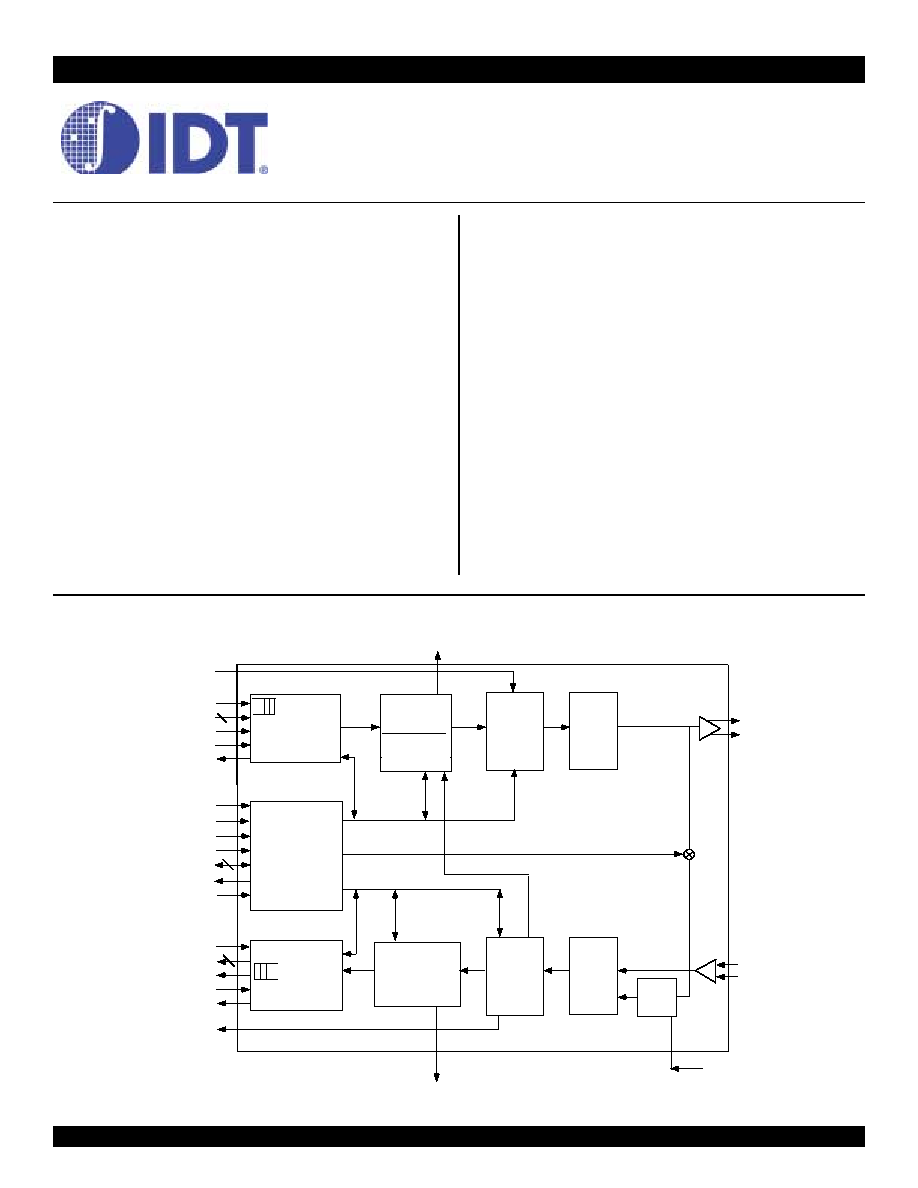
1 of 30
September 20, 2001
2001 Integrated Device Technology, Inc.
DSC 6030
IDT and the IDT logo are registered trademarks of Integrated Device Technology, Inc.
Single Port PHY (Physical Layer)
for 25.6, 51.2, and 204.8 Mbps
ATM Networks and Backplane
Applications
Features
Features
Features
Features
!
Performs the PHY-Transmission Convergence (TC) and
Physical Media Dependent (PMD) Sublayer functions of the
Physical Layer
!
Compliant to ATM Forum (af-phy-040.000) and ITU-T I.432.5
specifications for 25.6 Mbps physical interface
!
Operates at 25.6, 51.2, 102.4, 204.8 Mbps data rates
!
Backwards Compatible with 77V106L25
!
8-bit UTOPIA Level 1 Interface
!
3-Cell Transmit & Receive FIFOs
!
Receiver Auto-Synchronization and Good Signal Indication
!
LED Interface for status signalling
!
Supports UTP Category 3 and 5 physical media
!
Interfaces to standard magnetics
!
Low-Power CMOS
!
3.3V supply with 5V tolerant inputs
!
64-lead TQFP Package (10 x 10 mm)
!
Commercial and Industrial Temperature Ranges
Description
Description
Description
Description
The IDT77V126L200 is a member of IDT's family of products
supporting Asynchronous Transfer Mode (ATM) data communications
and networking. The IDT77V126L200 implements the physical layer for
25.6 Mbps ATM, connecting a serial copper link (UTP Category 3 and 5)
to an ATM layer device such as a SAR or a switch ASIC. The
IDT77V126L200 also operates at 51.2 and 204.8 Mbps and is well
suited to backplane driving applications. The 77V126L200 utilizes an 8-
bit UTOPIA1 interface on the cell side.
The IDT77V126L200 is fabricated using IDT's state-of-the-artCMOS
technology, providing the highest levels of integration, performance and
reliability, with the low-power consumption characteristics of CMOS.
Applications
Applications
Applications
Applications
!
Up to 204.8Mbps backplane transmission
!
Rack-to-rack short links
!
ATM Switches
Block Diagram
Block Diagram
Block Diagram
Block Diagram
TXREF
TXDATA
TXSOC
TXEN
ALE
RXCLAV
WR
RD
CS
AD[7:0]
INT
RXDATA
RXSOC
RXEN
TXCLAV
RXREF
3 CELL FIFO
9
8
9
UTILITY
BUS
CONTROLLER
3 CELL FIFO
SCRAMBLER
PRNG
DESCRAMBLER
5B/4B
DECODER
S/P
DNRZI
4B/5B
ENCODER
P/S
NRZI
CLK
REC
TXD+
Line
Driver
TXD-
Line
RXVR
RXD+
RXD-
LOOP BACK
RESET
RxLED
OSC
77V106
TXLED
RESET
TXCLK
RXCLK
77V126
Pseudo Random
Nibble Gener-
ator
IDT77V126L200

2 of 30
September 20, 2001
IDT77V126L200
77V126L200 Overview
77V126L200 Overview
77V126L200 Overview
77V126L200 Overview
The 77V126L200 is a physical layer interface chip for up to 200Mbps
data rate ATM network communications as defined by ATM Forum docu-
ment af-phy-040.000 and ITU-T I.432.5. The physical layer is divided
into a Physical Media Dependent sub layer (PMD) and Transmission
Convergence (TC) sub layer. The PMD sub layer includes the functions
for the transmitter, receiver and clock recovery for operation across 100
meters of category 3 and 5 unshielded twisted pair (UTP) cable. This is
referred to as the Line Side Interface. The TC sub layer defines the line
coding, scrambling, data framing and synchronization.
On the cell side, the 77V126L200 connects to an ATM layer device
(such as a switch core or SAR) through an 8-bit Utopia Level 1 interface.
The 77V126L200 is based on the 77105 and maintains significant
register compatibility with it, but it also has additional register features.
Access to these status and control registers is through the utility bus.
This is an 8-bit muxed address and data bus, controlled by a conven-
tional asynchronous read/write handshake.
Additional pins permit insertion and extraction of an 8kHz timing
marker, and provide LED indication of receive and transmit status.
Auto-Synchronization and Good Signal
Auto-Synchronization and Good Signal
Auto-Synchronization and Good Signal
Auto-Synchronization and Good Signal
Indication
Indication
Indication
Indication
The 77V126L200 features a new receiver synchronization algorithm
that allow it to achieve 4b/5b symbol framing on any valid data stream.
This is an improvement on earlier products which could frame only on
the escape symbol, which occurs only in start-of-cell or 8kHz (X8) timing
marker symbol pairs.
ATM25 transceivers always transmit valid 4b/5b symbols, allowing
the 77V126L200 receive section to achieve symbol framing and properly
indicate receive signal status, even in the absence of ATM cells or 8kHz
(X8) timing markers in the receive data stream. A state machine moni-
tors the received symbols and asserts the "Good Signal" status bit when
a valid signal is being received. "Good Signal" is deasserted and the
receive FIFO is disabled when the signal is lost. This is sometimes
referred to as Loss of Signal (LOS).
Operation
Operation
Operation
Operation at
at
at
at Speeds Greater Than 25
Speeds Greater Than 25
Speeds Greater Than 25
Speeds Greater Than 25 M
M
M
Mbps
bps
bps
bps
In addition to operation at the standard rate of 25.6 Mbps, the
77V126L200 is also specified to operate at 51.2 and 204.8 Mbps.
Except for the higher bit rates, all other aspects of operation are identical
to the 25.6 Mbps mode.
The rate is determined by the frequency of the clock applied to the
OSC input pin. OSC is 32 MHz for the 25.6 Mbps line rate, and 64 MHz
for the 51.2 and 204.8 Mbps line rate.
See Figure 16 for recommended line magnetics. Magnetics for 51.2
Mbps operation have a higher bandwidth than magnetics optimized for
25.6 Mbps. For 204.8Mbps data rate applications, ST6200T magnetics
from Pulse Engineering can be used. These magnetics have been
tested to work over 10 meters of UTP 5 cable at 204.8Mbps. Table 1
shows some of the different data rates the PHY can operate at using a
32MHz or 64MHz oscillator. Note that any oscillator frequency between
32MHz and 64MHz can be used. For example, if a 48MHz oscillator is
used and the multiplier is set to 4x, the data rate would be 153.6Mbps.
Reference
Clock (OSC)
Clock Multiplier
Control Bits
(Enhanced Control 2
Registers)
Line Bit
Rate
(MHz)
Data
Rate
(Mbps)
32 MHz
00 (1x)
32
25.6
01 (2x)
64
51.2
10 (4x)
128
102.4
64 MHz
00 (1x)
64
51.2
01 (2x)
128
102.4
10 (4x)
256
204.8
Table 1 200 Speed Grade Option

3 of 30
September 20, 2001
IDT77V126L200
Figure 1 Pin Assignments
1
2
3
4
5
6
7
8
9
10
11
12
13
14
15
16
RXREF
TXREF
TXLED
TXDATA0
TXDATA1
TXDATA2
TXDATA3
TXDATA4
TXDATA5
TXDATA6
TXDATA7
TXEN
TXSOC
VDD
TXCLAV
T
X
C
L
K
R
X
E
N
R
X
C
L
A
V
R
X
S
O
C
G
N
D
R
X
P
A
R
I
T
Y
R
X
D
A
T
A
7
R
X
D
A
T
A
6
R
X
D
A
T
A
5
R
X
D
A
T
A
4
V
D
D
R
X
D
A
T
A
3
R
X
D
A
T
A
2
R
X
D
A
T
A
1
R
X
D
A
T
A
0
17 18 19
21 22 23 24 25 26 27 28 29 30
32
20
31
33
34
35
36
37
38
39
40
41
42
43
44
45
46
47
48
AD7
AD6
AD5
AD4
GND
AD3
AD2
AD1
AD0
ALE
CS
RD
WR
RST
INT
RXLED
49
50
51
52
53
54
55
56
57
58
59
60
61
62
63
64
S
E
A
G
N
D
A
V
D
D
O
S
C
A
G
N
D
A
V
D
D
A
G
N
D
A
V
D
D
R
X
D
-
R
X
D
+
A
V
D
D
G
N
D
T
X
D
-
T
X
D
+
S
M
77v106L200 drw 02
R
X
C
L
K
TXPARITY
V
D
D
77v106 drw 02
Pin 1 Index
IDT77V106L200
77V126

4 of 30
September 20, 2001
IDT77V126L200
Signal Descriptions
Signal Descriptions
Signal Descriptions
Signal Descriptions
Line Side Signals
Signal Name Pin Number
I/O
Signal Description
RXD+, RXD-
58, 57
In
Positive and negative receive differential input pair.
TXD+, TXD-
62, 61
Out
Positive and negative transmit differential output pair.
Utility Bus Signals
Signal Name Pin Number
I/O
Signal Description
AD[7:0]
48, 47, 46,
45, 43, 42,
41, 40
In/
Out
Utility bus address/data bus. The address input is sampled on the falling edge of ALE. Data is output on this bus when a read
is performed. Input data is sampled at the completion of a write operation.
ALE
39
In
Utility bus address latch enable. Asynchronous input. An address on the AD bus is sampled on the falling edge of ALE. ALE
must be low when the AD bus is being used for data.
CS
38
In
Utility bus asynchronous chip select. CS must be asserted to read or write an internal register. It may remain asserted at all
times if desired.
RD
37
In
Utility bus read enable. Active low asynchronous input. After latching an address, a read is performed by deasserting WR
and asserting RD and CS.
WR
36
In
Utility bus write enable. Active low asynchronous input. After latching an address, a write is performed by deasserting RD,
placing data on the AD bus, and asserting WR and CS. Data is sampled when WR or CS is deasserted.
Utopia Bus Signals
Signal Name Pin Number
I/O
Signal Description
RXCLAV
20
Out
"Utopia Receive Cell Available. "1" indicates that the receive FIFO contains a complete cell. "0" indicates that it does not.
RXCLK
18
In
Utopia Receive Clock. This is a free running clock input.
RXDATA[7:0] 24, 25, 26,
27, 29, 30,
31, 32
Out
Utopia Receive Data. When one of the four ports is selected, the 77V126L200 transfers received cells to an ATM device
across this bus. Also see RXPARITY.
RXEN
19
In
Utopia Receive Enable. Driven by an ATM device to indicate its ability to receive data across the RXDATA bus.
RXPARITY
23
Out
Utopia Receive Data Parity. Odd parity over RXDATA[7:0].
RXSOC
21
Out
Utopia Receive Start of Cell. Asserted coincident with the first word of data for each cell on RXDATA.
TXCLAV
16
Out
"Utopia Transmit Cell Available. "1" indicates that the transmit FIFO has room available for at least one complete cell. "0"
indicates that it does not.
TXCLK
17
In
Utopia Transmit Clock. This is a free running clock input.
TXDATA[7:0] 11, 10, 9, 8,
7, 6, 5, 4
In
Utopia Transmit Data. An ATM device transfers cells across this bus to the 77V126L200 for transmission. Also see TXPAR-
ITY.
TXEN
13
In
Utopia Transmit Enable. Driven by an ATM device to indicate it is transmitting data across the TXDATA bus.
TXPARITY
12
In
Utopia Transmit Data Parity. Odd parity across TXDATA[7:0]. Parity is checked and errors are indicated in the Interrupt Sta-
tus Registers, as enabled in the Master Control Register. No other action is taken in the event of an error. Tie high or low if
unused.
TXSOC
14
In
Utopia Transmit Start of Cell. Asserted coincident with the first word of data for each cell on TXDATA.
Table 2 Signal Descriptions (Part 1 of 2)

5 of 30
September 20, 2001
IDT77V126L200
Miscellaneous Signals
Signal Name Pin Number
I/O
Signal Description
INT
34
Out
Interrupt. INT is an open-drain output, driven low to indicate an interrupt. Once low, INT remains low until the interrupt status
in the appropriate interrupt Status Register is read. Interrupt sources are programmable via the interrupt Mask Registers.
OSC
52
In
TTL line rate clock source, driven by a 100 ppm oscillator. 32 MHz for 25.6 Mbps; 64 MHz for 51.2 Mbps.
RST
35
In
Reset. Active low asynchronous input resets all control logic, counters and FIFOs. A reset must be performed after power up
prior to normal operation of the part.
RXLED
33
Out
Receive LED driver. Driven low for 223 cycles of OSC, beginning with RXSOC when a good (non-null and non-errored) cell
is received. Drives 8 mA both high and low.
RXREF
1
Out
Receive Reference. Active low. RXREF pulses low for a programmable number of clock cycles when an X_8 command byte
is received.
SE
49
In
Reserved signal. This input must be connected to logic low.
SM
64
In
Reserved signal. This input must be connected to logic low.
TXLED
3
Out
Transmit LED driver. Goes low for 223 cycles of OSC, beginning with TXSOC when a cell is received for transmission. 8 mA
drive current both high and low
TXREF
2
In
Transmit Reference. At the falling edge of TXREF, an X_8 command byte is inserted into the transmit data stream. Typical
application is WAN timing.
Power Supply Signals
Signal Name Pin Number
I/O
Signal Description
AGND
50, 53, 55
--
Analog ground. AGND is ground the analog portion of the ship, which sources a more constant current than the digital por-
tion.
AVDO
51, 54, 56,
59
--
Analog power supply. AVDD supplies power to the analog portion of the chip, which draws a more constant current than the
digital portion. 3.3 + 0.3V
GND
22, 44, 60
--
Digital Ground.
VDD
15, 28, 63
--
Digital power supply. 3.3 + 0.3V.
Table 2 Signal Descriptions (Part 2 of 2)

6 of 30
September 20, 2001
IDT77V126L200
Functional Description
Functional Description
Functional Description
Functional Description
Transmission Convergence (TC) Sub Layer
Transmission Convergence (TC) Sub Layer
Transmission Convergence (TC) Sub Layer
Transmission Convergence (TC) Sub Layer
Introduction
The TC sub layer defines the line coding, scrambling, data framing
and synchronization. Under control of a switch interface or Segmenta-
tion and Reassembly (SAR) unit, the 25.6Mbps ATM PHY accepts a 53-
byte ATM cell, scrambles the data, appends a command byte to the
beginning of the cell, and encodes the entire 53 bytes before transmis-
sion. These data transformations ensure that the signal is evenly distrib-
uted across the frequency spectrum. In addition, the serialized bit
stream is NRZI coded. An 8kHz timing sync pulse may be used for
isochronous communications.
Data Structure and Framing
Each 53-byte ATM cell is preceded with a command byte. This byte
is distinguished by an escape symbol followed by one of 17 encoded
symbols. Together, this byte forms one of seventeen possible command
bytes. Three command bytes are defined:
1. X_X (read: 'escape' symbol followed by another 'escape'): Start-
of-cell with scrambler/descrambler reset.
2. X_4 ('escape' followed by '4'): Start-of-cell without scrambler/
descrambler reset.
3. X_8 ('escape' followed by '8'): 8kHz timing marker. This
command byte is generated when the 8kHz sync pulse is
detected, and has priority over all line activity (data or command
bytes). It is transmitted immediately when the sync pulse is
detected. When this occurs during a cell transmission, the data
transfer is temporarily interrupted on an octet boundary, and the
X_8 command byte is inserted. This condition is the only allowed
interrupt in an otherwise contiguous transfer.
Below is an illustration of the cell structure and command byte
usage:
{X_X} {53-byte ATM cell} {X_4} {53-byte ATM {X_8} cell}...
In the above example, the first ATM cell is preceded by the X_X start-
of-cell command byte which resets both the transmitter-scrambler and
receiver-descrambler pseudo-random nibble generators (PRNG) to their
initial states. The following cell illustrates the insertion of a start-of-cell
command without scrambler/descrambler reset. During this cell's trans-
mission, an 8kHz timing sync pulse triggers insertion of the X_8 8kHz
timing marker command byte.
Transmission Description
Refer to Figure 2. Cell transmission begins with the PHY-ATM Inter-
face. An ATM layer device transfers a cell into the 77V126L200 across
the Utopia transmit bus. This cell enters a 3-cell deep transmit FIFO.
Once a complete cell is in the FIFO, transmission begins by passing the
cell, four bits (MSB first) at a time to the 'Scrambler'.
The `Scrambler' takes each nibble of data and exclusive-ORs them
against the 4 high order bits (X(t), X(t-1), X(t-3)) of a 10 bit pseudo-
random nibble generator (PRING). Its function is to provide the appro-
priate frequency distribution for the signal across the line.
The PRNG is clocked every time a nibble is processed, regardless of
whether the processed nibble is part of a data or command byte. Note
however that only data nibbles are scrambled. The entire command
byte (X _C) is NOT scrambled before it's encoded (see diagram for
illustration).
The PRNG is based upon the following polynomial:
X
10
+ X
7
+ 1
With this polynomial, the four output data bits (D3, D2, D1, D0) will
be generated from the following equations:
D3 = d3 xor X(t-3)
D2 = d2 xor X(t-2)
D1 = d1 xor X(t-1)
D0 = d0 xor X(t)
The following nibble is scrambled with X(t+4), X(t+3), X(t+2), and
X(t+1).
A scrambler lock between the transmitter and receiver occurs each
time an X_X command is sent. An X_X command is initiated only at the
beginning of a cell transfer after the PRNG has cycled through all of its
states (2
10
- 1 = 1023 states). The first valid ATM data cell transmitted
after power on will also be accompanied with an X_X command byte.
Each time an X_X command byte is sent, the first nibble after the last
escape (X) nibble is XOR'd with 1111b (PRNG = 3FFx).
Because a timing marker command (X_8) may occur at any time, the
possibility of a reset PRNG start-of-cell command and a timing marker
command occurring consecutively does exist (e.g. X_X_X_8). In this
case, the detection of the last two consecutive escape (X) nibbles will
cause the PRNG to reset to its initial 3FFx state. Therefore, the PRNG is
clocked only after the first nibble of the second consecutive escape pair.
Once the data nibbles have been scrambled using the PRNG, the
nibbles are further encoded using a 4b/5b process. The 4b/5b scheme
ensures that an appropriate number of signal transitions occur on the
line. A total of seventeen 5-bit symbols are used to represent the sixteen
4-bit data nibbles and the one escape (X) nibble. The table below lists
the 4-bit data with their corresponding 5-bit symbols:
Data
0000
0100
1000
1100
Symbol
10101
00111
10010
10111
Symbol
01001
01101
11001
11101
Data
0001
0101
1001
1101
Symbol
01010
01110
11010
11110
Data
0010
0110
1010
1110
Data
0011
0111
1011
1111
ESC(X) = 00010
3505 drw 05a
Symbol
01011
01111
11011
11111
.
.

7 of 30
September 20, 2001
IDT77V126L200
Transmit Block Diagram
Transmit Block Diagram
Transmit Block Diagram
Transmit Block Diagram
Figure 2 TC Transmit Block Diagram
PHY-ATM
Interface
Control,
HEC Gen. &
Insertion
Scrambler
4
Command
Byte
Insertion
4
PRNG
4
Scramble
Nibble
Next
Reset
4b/5b
Encoding
4
NRZI
Encoding
1
TX +
TX -
32MHz
64MHz
Clock Input
TXRef
(8kHz)
3 Cells
Start of Cell
UTOPIA
Interface
3505 drw 05
Line Rate Clock
Pseudo Random
Nibble Generator

8 of 30
September 20, 2001
IDT77V126L200
This encode/decode implementation has several very desirable
properties. Among them is the fact that the output data bits can be
represented by a set of relatively simple symbols;
!
Run length is limited to <= 5;
!
Disparity never exceeds +/- 1.
On the receiver, the decoder determines from the received symbols
whether a timing marker command (X_8) or a start-of-cell command was
sent (X_X or X_4). If a start-of-cell command is detected, the next 53
bytes received are decoded and forwarded to the descrambler. (See the
TC Receive Block Diagram).
The output of the 4b/5b encoder provides serial data to the NRZI
encoder. The NRZI code transitions the wire voltage each time a '1' bit is
sent. This, together with the previous encoding schemes guarantees
that long run lengths of either '0' or '1's are prevented. Each symbol is
shifted out with its most significant bit sent first.
When no cells are available to transmit, the 77V126L200 keeps the
line active by continuing to transmit valid symbols. But it does not
transmit another start-of-cell command until it has another cell for trans-
mission. The 77V126L200 never generates idle cells.
Transmit HEC Byte Calculation/Insertion
Byte #5 of each ATM cell, the HEC (Header Error Control) is calcu-
lated automatically across the first 4 bytes of the cell header, depending
upon the setting of bit 5 of the LED Driver and HEC Status/Control
Register (0x03). This byte is then either inserted as a replacement of the
fifth byte transferred to the PHY by the external system, or the cell is
transmitted as received. A third operating mode provides for insertion of
"Bad" HEC codes which may aid in communication diagnostics. These
modes are controlled by the LED Driver and HEC Status/Control Regis-
ters.
Receiver Description
The receiver side of the TC sublayer operates like the transmitter, but
in reverse. The data is NRZI decoded before each symbol is reassem-
bled. The symbols are then sent to the 5b/4b decoder, followed by the
Command Byte Interpreter, De-Scrambler, and finally through a FIFO to
the UTOPIA interface to an ATM Layer device.
ATM Cell Format
Note that although the IDT77V126L200 can detect symbol and HEC
errors, it does not attempt to correct them.
Bit 7
Bit 0
Header Byte 1
Header Byte 2
Header Byte 3
Header Byte 4
UDF
Payload Byte 1
∑
∑
∑
Payload Byte 48
3505 drw 52
UDF = User Defined Field (or HEC)
.
Good Signal Bit
Upon resetting the device or re-establishing a serial link, logic in front
of the 4b/5b decoder uses feedback from the 4b/5b decoder to deter-
mine if it is not properly "framed" on the 5-bit symbols being received. If
not properly framed, it will shift its framing, one bit at a time, until it
achieves proper symbol framing. Receipt of an Escape (X) symbol will
also force proper symbol framing.
The IDT77V126L200 monitors line conditions and can provide an
interrupt if the line is deemed 'bad'. The Interrupt Status Register
contains a Good Signal Bit (bit 6, set to 0 = Bad signal initially) which
shows the status of the line per the following algorithm:
To declare 'Good Signal' (from "Bad" to "Good")
There is an up-down counter that counts from 7 to 0 and is initially
set to 7. When the clock ticks for 1,024 cycles (32MHz clock, 1,024
cycles = 204.8 symbols) and no "bad symbol" has been received, the
counter decreases by one. However, if at least one "bad symbol" is
detected during these 1,024 clocks, the counter is increased by one, to
a maximum of 7. The Good Signal Bit is set to 1 when this counter
reaches 0. The Good Signal Bit could be set to 1 as quickly as 1,433
symbols (204.8 x 7) if no bad symbols have been received.
To declare 'Bad Signal' (from "Good" to "Bad")
The same up-down counter counts from 0 to 7 (being at 0 to provide
a "Good" status). When the clock ticks for 1,024 cycles (32MHz clock,
1,024 cycles = 204.8 symbols) and there is at least one "bad symbol",
the counter increases by one. If it detects all "good symbols" and no
"bad symbols" in the next time period, the counter decreases by one.
The "Bad Signal" is declared when the counter reaches 7. The Good
Signal Bit could be set to 0 as quickly as 1,433 symbols (204.8 x 7) if at
least one "bad symbol" is detected in each of seven consecutive groups
of 204.8 symbols.
8kHz Timing Marker
The 8kHz timing marker, described earlier, is a completely optional
feature which is essential for some applications requiring synchroniza-
tion for voice or video, and unnecessary for other applications. When
unused, TXREF should be tied high. Also note that it is not limited to
8kHz, should a different frequency be desired. When looped, a received
X_8 command byte causes one to be generated on the transmit side.
A received X_8 command byte causes the 77V126L200 to issue a
negative pulse on RXREF.
PHY-ATM Interface
PHY-ATM Interface
PHY-ATM Interface
PHY-ATM Interface
UTOPIA Level 1 is a Physical (PHY) Layer to ATM Layer interface
standardized by the ATM Forum. It is used for transferring ATM cells
and has separate transmit and receive channels and specific hand-
shaking protocols. It is defined in ATM Forum documents af-phy-0017
and af-phy-0039.
There is a single 8-bit data bus in the transmit (ATM-to-PHY) direc-
tion, and a single 8-bit data bus in the receive (PHY-to-ATM) direction.
In addition to the data bus, each direction also includes a single optional
parity bit and several handshaking signals. Please note that the transmit
bus and the receive bus operate completely independently.

9 of 30
September 20, 2001
IDT77V126L200
Receive Block Diagram
Receive Block Diagram
Receive Block Diagram
Receive Block Diagram
Figure 3 Receive Block Diagram
4
PHY-ATM
Interface
Control -
RECV
4
5
NRZI
Decoding
RX +
RX
4
4
PRNG
Scramble
Nibble
Next
Reset
RXRef
32.0MHz
Clock
Synthesizer
& PLL
5b/4b
Decoding
Command
Byte
Detection,
Removal,
& Decode
De-
Scrambler
3505 drw 06
OSC
3 Cells
Start of Cell
UTOPIA
Interface
.
Recovery
Clock Recovery
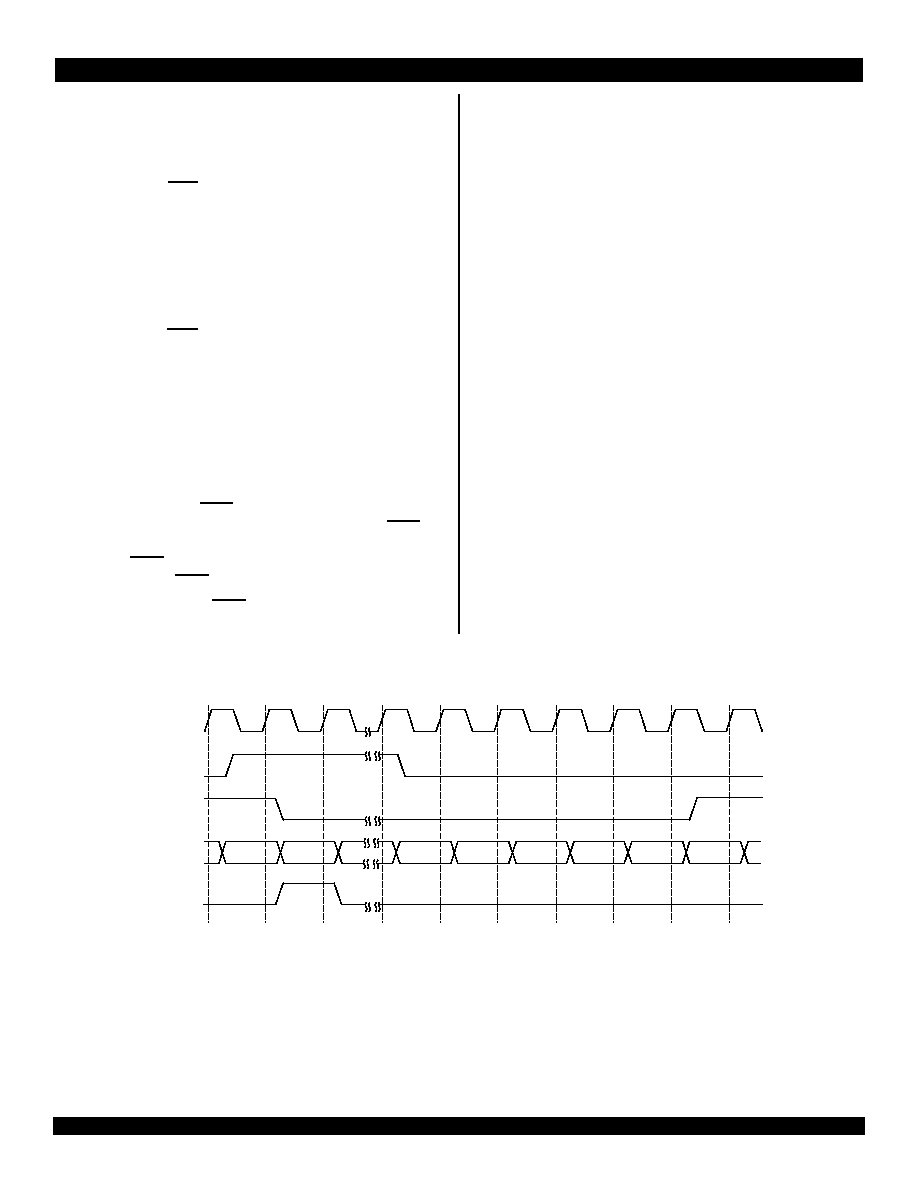
10 of 30
September 20, 2001
IDT77V126L200
The Utopia signals are summarized below:
Transmit and receive both utilize free running clocks, which are
inputs to the 77V126. All Utopia signals are timed to these clocks.
In the transmit direction, the PHY first asserts TXCLAV (transmit cell
available) to indicate that it has room in its transmit FIFO to accept at
least one 53-byte ATM cell. When the ATM layer device is ready to begin
passing the cell, it asserts TXEN (transmit enable) and TXSOC (start of
cell), coincident with the first byte of the cell on TXDATA. TXEN can
remain asserted for the duration of the cell transfer, or the ATM device
may deassert TXEN at any time once the cell transfer has begun; data is
transferred only when TXEN is asserted.
In the receive direction, RXEN indicates when the ATM device is
prepared to receive data. As with transmit, it may be asserted or deas-
serted at any time.
TXDATA[7:0]
ATM to PHY
TXPARITY
ATM to PHY
TXSOC
ATM to PHY
TXEN
ATM to PHY
TXCLAV
PHY to ATM
TXCLK
ATM to PHY
RXDATA[7:0]
PHY to ATM
RXPARITY
PHY to ATM
RXSOC
PHY to ATM
RXEN
ATM to PHY
RXCLAV
PHY to ATM
RXCLK
ATM to PHY
Note that this Utopia interface can be operated in either cell-mode or
in byte-mode as determined by bit 1 in the Master Control Register. In
cell-mode, which is the default, the 77V126L200 does not assert
TXCLAV until it has enough room in it's transmit FIFO to accept a
complete cell, and doesn't assert RXCLAV until it has a complete cell in
the receive FIFO. It will not deassert TXCLAV or RXCLAV until at or near
the end of the transfer of a cell.
In byte-mode, the phy can assert TXCLAV before it has room for a
complete cell. It will modulate TXCLAV to prevent the FIFO from over-
flowing. Likewise, it may assert RXCLAV before a complete cell has
been received, and will modulate RXCLAV to prevent the FIFO from
underflowing. There is generally little advantage to the byte-mode, so
most users will leave the 77V126L200 in the default cell-mode.
In both transmit and receive, TXSOC and RXSOC (start of cell) is
asserted for one clock, coincident with the first byte of each cell. Odd
parity is utilized across each 8-bit data field, which means that for an all-
zero pattern. the corresponding parity bit is one.
The following figures show examples of the Utopia Level 1 hand-
shake.
Figure 4 Utopia Transmit Handshake - Single Cell
TXCLK
TXSOC
TXCLAV
TXEN
TXDATA[7:0],
TXPARITY
X
H1
H2
P44
P45
P46
P47
P48
X
77v126drw16

11 of 30
September 20, 2001
IDT77V126L200
Figure 5 Utopia Transmit Handshake - Back to Back Cells and TXEN Suspended Transmission
Figure 6 Utopia Transmit Handshake - TXEN Suspended Transmission and Back to Back Cells (Octet Mode Only)
Figure 7 Utopia Transmit Handshake - Delay Between Cells
TXCLK
TXSOC
TXCLAV
TXEN
TXDATA[7:0],
TXPARITY
P46
P47
P48
H1
H2
H3
H4
X
H5
77v106 drw
77v126drw17
TXCLK
TXSOC
TXCLAV
TXEN
TXDATA[7:0],
TXPARITY
P42
P43
P44
P45
P46
X
X
X
P47
P48
H1
77v126drw18
TXCLK
TXSOC
TXCLAV
TXEN
TXDATA[7:0],
TXPARITY
H1
H2
H3
P48
P47
High-Z
High-Z
77v126drw19
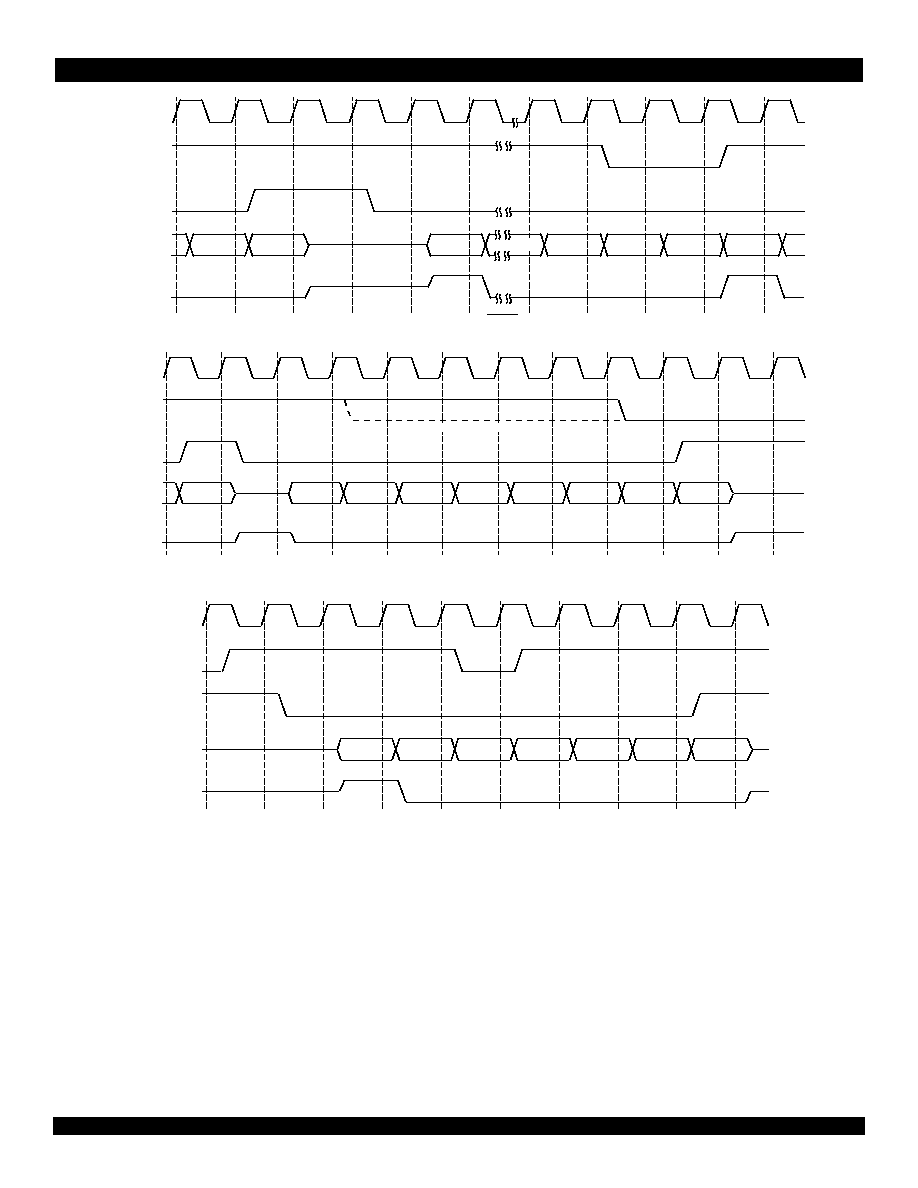
12 of 30
September 20, 2001
IDT77V126L200
Figure 8 Utopia Receive Handshake - RXEN and RXCLAV Control
Figure 9 Utopia Receive Handshake - RXCLAV Deassertion
Figure 10 Utopia Receive Handshake - RXCLAV Suspended Transfer (Octet Mode Only)
RXCLK
RXSOC
RXCLAV
RXEN
RXDATA[7:0],
RXPARITY
H1
P47
P48
P48
P47
High-Z
High-Z
X
X
H1
H2
77v126drw20
RXCLK
RXSOC
RXCLAV
RXEN
RXDATA[7:0],
RXPARITY
P48
X
P44
P42
High-Z
High-Z
P43
P45
P46
P47
High-Z
High-Z
X
Early RxCLAV option (bit 6=1, register 0x02)
77v126drw21
RXCLK
RXSOC
RXCLAV
RXEN
RXDATA[7:0],
RXPARITY
H1
H2
X
High-Z
High-Z
H3
H4
H5
P1
77v126drw22

13 of 30
September 20, 2001
IDT77V126L200
Control and Status Interface
Control and Status Interface
Control and Status Interface
Control and Status Interface
Utility Bus
Utility Bus
Utility Bus
Utility Bus
The Utility Bus is a byte-wide interface that provides access to the
registers within the IDT77V126L200. These registers are used to select
desired operating characteristics and functions, and to communicate
status to external systems.
The Utility Bus is implemented using a multiplexed address and data
bus (AD[7:0]) where the register address is latched via the Address
Latch Enable (ALE) signal.
The Utility Bus interface is comprised of the following pins:
AD[7:0], ALE, CS, RD, WR
Read Operation
Refer to the Utility Bus timing waveforms. A register read is
performed as follows:
1. Initial condition:
≠ RD, WR, CS not asserted (logic 1)
≠ ALE not asserted (logic 0)
2. Set up register address:
≠ place desired register address on AD[7:0]
≠ set ALE to logic 1;
≠ latch this address by setting ALE to logic 0.
3. Read register data:
≠ Remove register address data from AD[7:0]
≠ assert CS by setting to logic 0;
≠ assert RD by setting to logic 0
≠ wait minimum pulse width time (see AC specifications)
Write Operation
A register write is performed as described below:
1. Initial condition:
≠ RD, WR, CS not asserted (logic 1)
≠ ALE not asserted (logic 0)
2. Set up register address:
≠ place desired register address on AD[7:0]
≠ set ALE to logic 1;
≠ latch this address by setting ALE to logic 0.
3. Write data:
≠ place data on AD[7:0]
≠ assert CS by setting to logic 0;
≠ assert WR (logic 0) for minimum time (according to timing
specification); reset WR or CS to logic 1 to complete register
write cycle.
Interrupt Operations
Interrupt Operations
Interrupt Operations
Interrupt Operations
A variety of selectable interrupt and signalling conditions are
provided. They are useful both during `normal' operation, and as diag-
nostic aids. Refer to the Status and Control Register List section.
Overall interrupt control is provided via bit 0 of the Master Control
Register. When this bit is cleared (set to 0), interrupt signalling is
prevented. The Interrupt Mask Register allows individual masking of
different interrupt sources. Additional interrupt signal control is provided
by bit 5 of the Master Control Register. When this bit is set (=1), receive
cell errors will be flagged via interrupt signalling and all other interrupt
conditions are masked. These errors include:
!
Bad receive HEC
!
Short (fewer than 53 bytes) cells
!
Received cell symbol error
Normal interrupt operations are performed by setting bit 0 and
clearing bit 5 in the Master Control Register. INT (pin 34) will go to a
low state when an interrupt condition is detected. The external system
should then interrogate the 77V126L200 to determine which one (or
more) conditions caused this flag, and reset the interrupt for further
occurrences. This is accomplished by reading the Interrupt Status
Register. Decoding the bits in this byte will tell which error condition
caused the interrupt. Reading this register also:
!
clears the (sticky) interrupt status bits in the registers that are
read
!
resets INT
This leaves the interrupt system ready to signal an alarm for further
problems.
LED Control and Signaling
LED Control and Signaling
LED Control and Signaling
LED Control and Signaling
The LED outputs provide bi-directional LED drive capability of 8 mA.
As an example, the RxLED outputs are described in the truth table:
As illustrated in Figure 11, this could be connected to provide for a
two-LED condition indicator. These could also be different colors to
provide simple status indication at a glance. (The minimum value for R
should be 330
).
TxLED Truth Table
TxLED Truth Table
TxLED Truth Table
TxLED Truth Table
Diagnostic Functions
Diagnostic Functions
Diagnostic Functions
Diagnostic Functions
Figure 11 LED Indicator
State
Pin Voltage
Cells being received
Low
Cells not being received
High
State
Pin Voltage
Cells being transmitted
Low
Cells not being transmitted
High
RXLED
TXLED
3.3V
(Indicates: Cells
being received or
transmitted)
(Indicates: Cells are
not being received or
transmitted)
3505 drw 32
R
R

14 of 30
September 20, 2001
IDT77V126L200
Loopback
There are two loopback modes supported by the 77V126L200. The loopback mode is controlled via bits 1 and 0 of the Diagnostic Control Register:
Normal Mode
Figure 12 shows normal operating conditions: data to be transmitted is transferred to the TC, where it is queued and formatted for transmission by
the PMD. Receive data from the PMD is decoded along with its clock for transfer to the receiving "upstream system".
PHY Loopback
As Figure 13 shows, this loopback mode provides a connection within the PHY from the transmit PHY-ATM interface to the PHY-ATM receive inter-
face. Note that while this mode is operating, no data is forwarded to or received from the line interface.
Line Loopback
Figure 14 might also be called "remote loopback" since it provides for a means to test the overall system, including the line. Since this mode will
probably be entered under direction from another system (at a remote location), receive data is also decoded and transferred to the upstream system
to allow it to listen for commands. A common example would be a command asking the upstream system to direct the TC to leave this loopback state,
and resume normal operations.
Figure 12 Normal Mode
Figure 13 PHY Loopback
Figure 14 Line Loopback
Bit 1 Bit 0
Mode
0
0
Normal operating mode
1
0
PHY Loopback
1
1
Line Loopback
TC sublayer
PMD sublayer
Line
Interface
ATM Layer
Device
77v1054 drw 33
Utopia
Interface
ATM Layer
Device
TC sublayer
PMD sublayer
Line
Interface
77v1054 drw 34
Utopia
Interface
ATM Layer
Device
TC sublayer
PMD
sublayer
Line
Interface
77v1054 drw 35
Utopia
Interface

15 of 30
September 20, 2001
IDT77V126L200
Counters
Counters
Counters
Counters
Several condition counters are provided to assist external systems (e.g. software drivers) in evaluating communications conditions. It is anticipated
that these counters will be polled from time to time (user selectable) to evaluate performance.
!
Symbol Error Counters
≠ 8 bits
≠ counts all invalid 5-bit symbols received
!
Transmit Cell Counters
≠ 16 bits
≠ counts all transmitted cells
!
Receive Cell Counters
≠ 16 bits
≠ counts all received cells, excluding idle cells and HEC errored cells
!
Receive HEC Error Counters
≠ 5 bits
≠ counts all HEC errors received
The TxCell and RxCell counters are sized (16 bits) to provide a full cell count (without roll over) if the counter is read once/second. The Symbol
Error counter and HEC Error counter were given sufficient size to indicate exact counts for low error-rate conditions. If these counters overflow, a
gross condition is occurring, where additional counter resolution does not provide additional diagnostic benefit.
Reading Counters
1. Decide which counter value is desired. Write to the Counter Select Register to the bit location corresponding to the desired counter. This loads
the High and Low Byte Counter Registers with the selected counter's value, and resets this counter to zero.
Note: Only one counter may be enabled at any time in each of the Counter Select Registers.
2. Read the Counter Registers (low byte and high byte) to get the value.
Further reads may be accomplished in the same manner by writing to the Counter Select Registers.
Note: The PHY takes some time to set up the low and high byte counters after a specific counter has been selected in the Counter Selector
register. This time delay (in µS) varies with the line rate and can be calculated as follows:
Time delay (µS) = 12.5___
line rate (Mbps)
Loop Timing Feature
Loop Timing Feature
Loop Timing Feature
Loop Timing Feature
The 77v126 also offers a loop timing feature for specific applications where data needs to be repeated / transmitted using the recovered clock. If
the loop timing mode is enabled in the Enhanced Control Register 1 bit 6, the recovered receive clock is used as to clock out data on transmit side. In
normal mode, the transmitter transmits data using the multiplied oscillator clock.
Jitter in Loop Timing Mode
One of the primary concerns when using loop timing mode is the amount of jitter that gets added each time data is transmitted. Table 3 shows the
jitter measured at various data rates. The set-up shown in Figure 15 was used to perform these tests. The maximum jitter seen was at TX point 5 and
the minimum jitter was at point 2. The loop timing jitter is defined as the amount of jitter generated by each TX node. In other words, the loop timing
jitter or the jitter added by a loop-timed port in the set-up below is the difference between the Total Output Jitter and the Total Input Jitter.

16 of 30
September 20, 2001
IDT77V126L200
Figure 15 Test Setup for Loop Timing Jitter Measurements
Loop Timing Jitter Specification
The waveforms below show some of the measurements taken with the set-up in Figure 15. Using the formula above, the jitter specification was
derived. For example, at data rate of 25.6Mbps, jitter added going through Line Card 3 is 1.5ns -1.4ns (as shown in the waveforms below).
Line Rate
Mbps
Data Rate
Mbps
Min.
Typ.
Max.
Note
32
25.6
--
100 ps
--
Using 32Mhz OSC, multiplier at 1x
64
51.2
--
100 ps
--
Using 64Mhz OSC, multiplier at 1x
128
102.4
--
80 ps
--
Using 32Mhz OSC, multiplier at 4x
256
204.8
--
20 ps
--
Using 64Mhz OSC, multiplier at 4x
Table 3 Loop Timing Jitter
Data
Data
Data
Data
Data
Data
SWITCH
Loop Timing Mode
Loop Timing Mode
Loop Timing Mode
Line Card 2
Line Card 3
Line Card 4
CLK
CLK
CLK
RX
RX
RX
TX
TX
TX
TX
RX
Normal Mode
Line Card 1
OSC
1
2
3
4
5
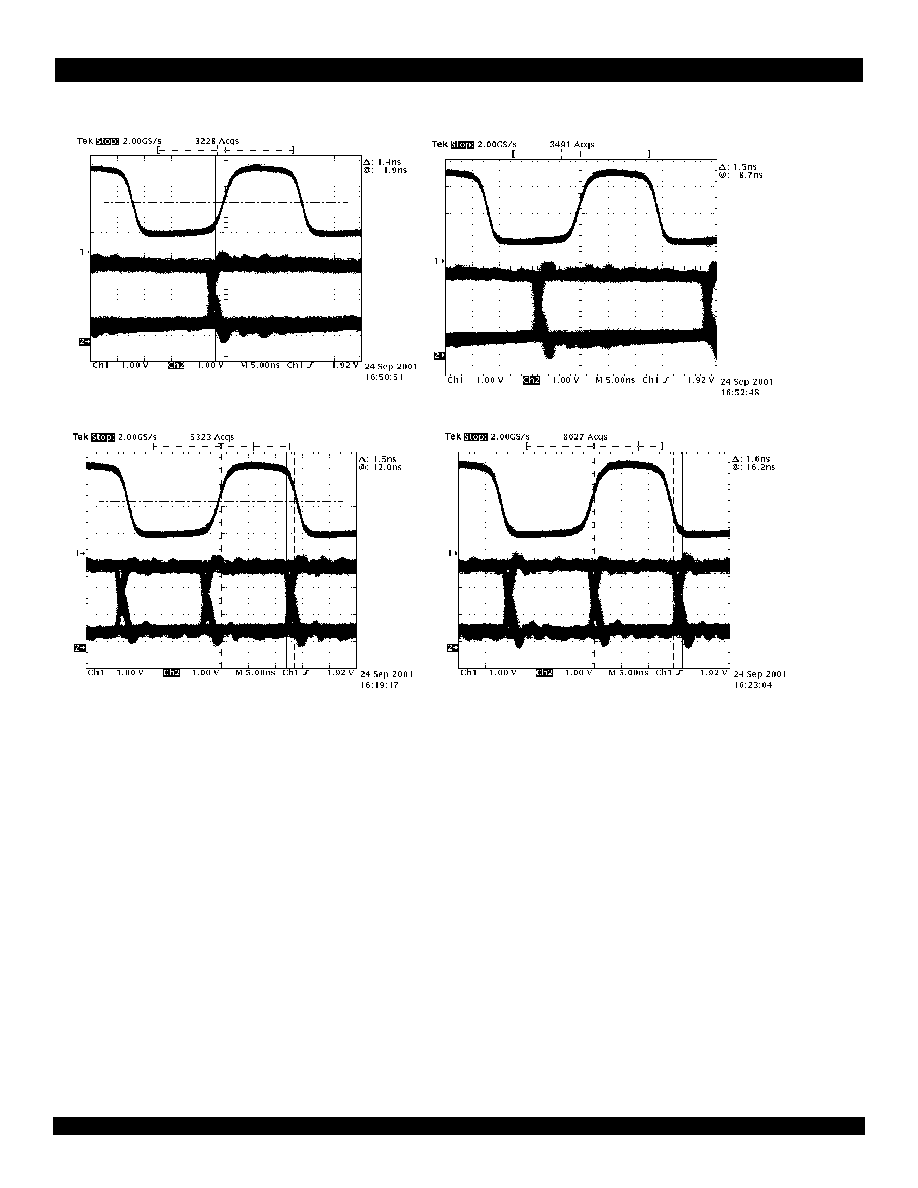
17 of 30
September 20, 2001
IDT77V126L200
Jitter at 25.6Mbps at point 4 with respect to point 1
Jitter at 25.6Mbps at point 5 with respect to point 1
Jitter at 51.2Mbps at point 4 with respect to point 1
Jitter at 51.2Mbps at point 5 with respect to point 1

18 of 30
September 20, 2001
IDT77V126L200
From the above measurements taken, the amount of jitter being added at each TX point is not significant. These tests were also run at line rates of
256Mbps for extended periods of time (64 hours) and no bit errors were seen.
Line Side (Serial) Interface
Line Side (Serial) Interface
Line Side (Serial) Interface
Line Side (Serial) Interface
PHY to Magnetics Interface
PHY to Magnetics Interface
PHY to Magnetics Interface
PHY to Magnetics Interface
A standard connection to 100
and 120
unshielded twisted pair cabling is shown in Figure 16. Note that the transmit signal is somewhat attenu-
ated in order to meet the launch amplitude specified by the standards. The external receive circuitry is designed to attenuate low frequencies in order
to compensate for the high frequency attenuation of the cable.
Also, the receive circuitry biases the positive and negative RX inputs to slightly different voltages. This is done so that the receiver does not receive
false signals in the absence of a real signal. This can be important because the 77V126L200 does not disable error detection or interrupts when an
input signal is not present.
When connecting to UTP at 51.2Mbps and 204.8Mbps, it is necessary to use magnetics with sufficient bandwidth. Refer to Table 5 on page 20 for
the recommended magnetics.
Jitter at 102.4Mbps at point 4 with respect to point 1
Jitter at 102.4Mbps at point 5 with respect to point 1
Jitter at 256Mbps at point 4 with respect to point 1
Jitter at 256Mbps at point 5 with respect to point 1

19 of 30
September 20, 2001
IDT77V126L200
PHY to Magnetics Interface
PHY to Magnetics Interface
PHY to Magnetics Interface
PHY to Magnetics Interface
Figure 16 Recommended Connection to Magnetics
Component
Value
Tolerance
R1
47
±5%
R2
47
±5%
R3
620
±5%
R4
110
±5%
R5
2.7k
±5%
R6
2.7k
±5%
R7
82
±5%
R8
33
±5%
R9
33
±5%
C1
0.1
µ
F
±20%
C2
0.1
µ
F
±20%
C3
0.1
µ
F
±20%
C4
0.1
µ
F
±20%
C5
0.1
µ
F
±20%
C6
0.1
µ
F
±20%
L1
3.3
µ
H
±20%
Table 4 Analog Component Values
14
16
11
9
7
2
5
Magnetics
R
J
4
5
C
o
n
n
e
c
t
o
r
IDT77V106
AGND
15
10
12
AGND
1
3
6
8
AGND
AVDD
RXD+
RXD-
TXD+
TXD-
R1
R2
R3
R4
R5
R8
R9
R7
C1
C2
L1
77v106 drw 36
R6
1
2
3
4
5
6
7
8
.
C5
C6
C3
C4
IDT77V126

20 of 30
September 20, 2001
IDT77V126L200
Status and Control Register List
Status and Control Register List
Status and Control Register List
Status and Control Register List
Master Control Register
Master Control Register
Master Control Register
Master Control Register
Address: 0x00
Interrupt Status Register
Interrupt Status Register
Interrupt Status Register
Interrupt Status Register
Address: 0x01
Magnetics Modules for 25.6 Mbps
Pulse PE-67583 or R4005
www.pulseeng.com
TDK TLA-6M103
www.component.tdk.com
Magnetics Module for 51.2 Mbps
Pulse R4005
www.pulseeng.com
Magnetics Module for 204.8 Mbps
Pulse ST6200T
www.pulseeng.com
Table 5 Magnetics Modules
Bit Type
Initial State
Function
7
R/W
Reserved
6
R/W
1 = discard
errored cells
Discard Receive Error Cells
On receipt of any cell with an error (e.g. short cell, invalid command mnemonic, receive HEC error (if enabled)), this
cell will be discarded and will not enter the receive FIFO.
5
R/W
0 = all interrupts Enable Cell Error Interrupts Only
If Bit 0 in this register is set (Interrupts Enabled), setting of this bit enables only "Received Cell Error" (as defined in bit
6) to trigger interrupt line."
4
R/W
0 = disabled
Transmit Data Parity Check
Directs TC to check parity of TxDATA against parity bit located in TXPARITY.
3
R/W
1 = discard
idle cells
Discard Received Idle Cells
Directs TC to discard received idle (VPI/VCI = 0 and GFC = 0) cells from PMD without signalling external systems.
2
R/W
0 = not halted
Halt Tx
Halts transmission of data from TC to PMD and forces the TxD outputs to the "0" state."
1
R/W
0 = cell mode
UTOPIA Mode Select:
0 = cell mode, 1 = byte mode.
0
R/W
1 = enable
interrupts
Enable Interrupt Pin (Interrupt Mask Bit)
Enables the INT output pin. If cleared, pin is always high and interrupt is masked. If set, an interrupt will be signaled
by setting the interrupt pin to "0". It doesn't affect the Interrupt Status Registers."
Nomenclature
"Reserved" register bits, if written, should always be written "0"
R/W = register may be read and written via the utility bus
R-only or W-only = register is read-only or write-only
sticky = register bit is cleared after the register containing it is read; all sticky bits are read-only
"0" = `cleared' or `not set'
"1" = `set'
Bit Type
Initial State
Function
7
0
Reserved
6
R
0 = Bad Signal Good Signal Bit See definitions earlier in this data sheet.
1 - Good Signal
0 - Bad Signal

21 of 30
September 20, 2001
IDT77V126L200
Diagnostic Control Register
Diagnostic Control Register
Diagnostic Control Register
Diagnostic Control Register
Address: 0x02
5
sticky 0
HEC error cell received Set when a HEC error is detected on received cell.
4
sticky 0
"Short Cell" Received
Interrupt signal which flags received cells with fewer than 53 bytes. This condition is detected when receiving Start-of-Cell
command bytes with fewer than 53 bytes between them."
3
sticky 0
Transmit Parity Error
If Bit 4 of the Master Control Register (Transmit Data Parity Check) is set, this interrupt flags a transmit data parity error con-
dition. Odd parity is used.
2
sticky 0
Receive Signal Condition change This interrupt is set when the received 'signal' changes either from 'bad to good' or from
'good to bad'.
1
sticky 0
Received Symbol Error Set when an undefined 5-bit symbol is received.
0
sticky 0
Receive FIFO Overflow Interrupt which indicates when the receive FIFO has filled and cannot accept additional data.
Bit Type Initial State
Function
7
R/W
0 = normal
Force TxCLAV Deassert
This feature can be used during line loopback mode to prevent cells from being passed across the Utopia bus for transmission.
6
R/W
0 = UTOPIA RxCLAV Operation Select
The UTOPIA standard dictates that during cell mode operation, if the receive FIFO no longer has a complete cell available for
transfer from PHY, RxCLAV is deasserted following transfer of the last byte out of the PHY
to the upstream system. With this bit set, early deassertion of this signal will occur coincident with the end of Payload byte 44 (as
in octet mode for TxCLAV). This provides early indication to the upstream system of this impending condition.
0 = "Standard UTOPIA RxCLAV"
1 = "Cell mode = Byte mode"
5 R/W
1 = tri-state Single/Multi-PHY Configuration Select
0 = single: Never tri-state RxDATA, RxPARITY and RxSOC
1 = Multi-PHY mode: Tri-state RxDATA, RxPARITY and RxSOC when RxEN = 1
4
R/W
0 = normal
RFLUSH = Clear Receive FIFO
This signal is used to tell the TC to flush (clear) all data in the receive FIFO. The TC signals this completion by clearing this bit.
3
R/W
0 = normal
Insert Transmit Payload Error
Tells TC to insert cell payload errors in transmitted cells. This can be used to test error detection and recovery systems at desti-
nation station, or, under loopback control, at the local receiving station. This payload error is accomplished by flipping bit 0 of the
last cell payload byte.
2
R/W
0 = normal
Insert Transmit HEC Error
Tells TC to insert HEC error in Byte 5 of transmitted cells. This can be used to test error detection and recovery systems in down-
stream switches, or, under loopback control, the local receiving station. The HEC error is accomplished by flipping bit 0 of the
HEC byte.
1, 0 R/W
00 = normal Loopback Control
bit # 1 0
0 0 Normal mode (receive from network)
1 0 PHY Loopback
1
1 1 Line Loopback
0 1 PHY Loopback (with clock recovery)
1.
When Bits [1:0] in the Diagnostic Control Registers are set to 10, the PHY loopback mode works only if clock multiplier is 1x. For higher multiplies, these bits must be set to 01.

22 of 30
September 20, 2001
IDT77V126L200
LED Driver and HEC Status/Control Register
LED Driver and HEC Status/Control Register
LED Driver and HEC Status/Control Register
LED Driver and HEC Status/Control Register
Address: 0x03
Low Byte Counter Register [7:0]
Low Byte Counter Register [7:0]
Low Byte Counter Register [7:0]
Low Byte Counter Register [7:0]
Address: 0x04
High Byte Counter Register [15:8]
High Byte Counter Register [15:8]
High Byte Counter Register [15:8]
High Byte Counter Register [15:8]
Address: 0x05
Counter Select Register
Counter Select Register
Counter Select Register
Counter Select Register
Address: 0x06
Note: For proper operation, only one bit may be set in the Counter Selected Register at any time.
Bit Type
Initial State
Function
7
R
0
Reserved
6
R/W
0 = enable
checking
Disable Receive HEC Checking (HEC Enable)
When not set, the HEC is calculated on first 4 bytes of received cell, and compared against the 5th byte. When set (=
1), the HEC byte is not checked.
5
R/W
0 = enable calcu-
late & replace
Disable Transmit HEC Calculate & Replace
When set, the 5th header byte of cells queued for transmit is not replaced with the HEC calculated across the first four
bytes of that cell.
4,3 R/W
00 = 1 cycle
RxREF Pulse Width Select
bit # 4 3
0 0 RxREF active for 1 cycle of the recovered clock
0 1 RxREF active for 2 cycles of the recovered clock
1 0 RxREF active for 4 cycles of the recovered clock
1 1 RxREF active for 8 cycles of the recovered clock
2
R
1 = empty
Transmit FIFO Status 1 = TxFIFO empty 0 = TxFIFO not empty
1
R
1
TxLED Status 0 = Cell Transmitted 1 = Cell Not Transmitted
0
R
1
RxLED Status 0 = Cell Received 1 = Cell Not Received
Bit Type
Initial State
Function
[7:0] R
0x00
Provides low-byte of counter value selected via the Counter Select Register.
Bit Type
Initial State
Function
[7:0] R
0x00
Provides high-byte of counter value selected via the Counter Select Register.
Bit Type
Initial State
Function
7
--
0
Reserved
6
--
0
Reserved
5
--
0
Reserved
4
--
0
Reserved
3
W
0
Symbol Error Counter
2
W
0
Tx Cell Counter
1
W
0
Rx Cell Counter Does not count HEC errored cells. even when bit 6 of the Master Control Register is Cleared.
0
W
0
Receive Hec Error Counter
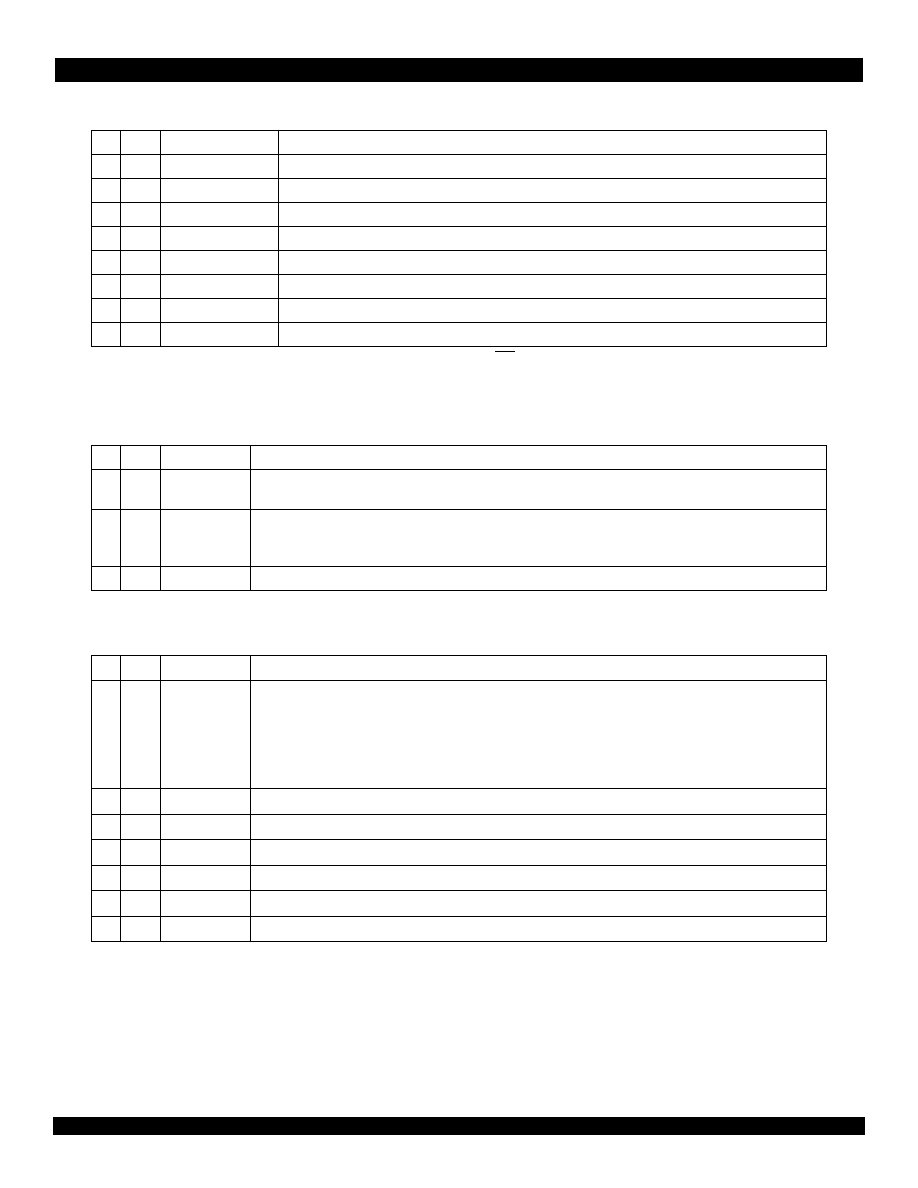
23 of 30
September 20, 2001
IDT77V126L200
Interrupt Mask Register
Interrupt Mask Register
Interrupt Mask Register
Interrupt Mask Register
Address: 0x07
Note: When set to "1", these bits mask the corresponding interrupt pin (INT). When set to "0", the interrupts are unmasked. These interrupts
correspond to the interrupt status bits in the interrupt Status Registers.
Enhanced Control 1 Register
Enhanced Control 1 Register
Enhanced Control 1 Register
Enhanced Control 1 Register
Address: 0x08
Enhanced Control 2 Registers
Enhanced Control 2 Registers
Enhanced Control 2 Registers
Enhanced Control 2 Registers
Addresses: 0x09
Bit Type
Initial State
Function
7
0
Reserved
6
0
Reserved
5
R/W
0 = interrupt enabled
HEC Error Cell
4
R/W
0 = interrupt enabled
Short Cell Error
3
R/W
0 = interrupt enabled
Transmit Parity Error
2
R/W
0 = interrupt enabled
Receive Signal Condition Change
1
R/W
0 = interrupt enabled
Received Cell Symbol Error
0
R/W
0 = interrupt enabled
Receive FIFO Overflow
Bit Type
Initial State
Function
7
W
0 = not reset
Software Reset
1 = Reset. This bit is self-clearing; it isn't necessary to write "0" to exit reset.
6
R/W
0 = OSC
Transmit Line Clock (or Loop Timing Mode)
When set to 0, the OSC input is used as the transmit line clock. When set to 1, the recovered receive clock is used as
the transmit line clock.
5-0
0
Reserved
Bit Type
Initial State
Function
7-6
R/W
00
Line Rate Control These bits determine the line bit rate relative to the reference clock, as well as the pre-driver
strength for the TXD+/- outputs.
00 Clock multiplier = 1x, pre-driver strength is "standard"
01 Clock multiplier = 2x, pre-driver strength is "standard"
10 Clock multiplier = 4x, pre-driver strength is "strong"
11 Reserved
5
0
Reserved
4
0
Reserved
3
0
Reserved
2
0
Reserved
1
0
Reserved
0
0
Reserved
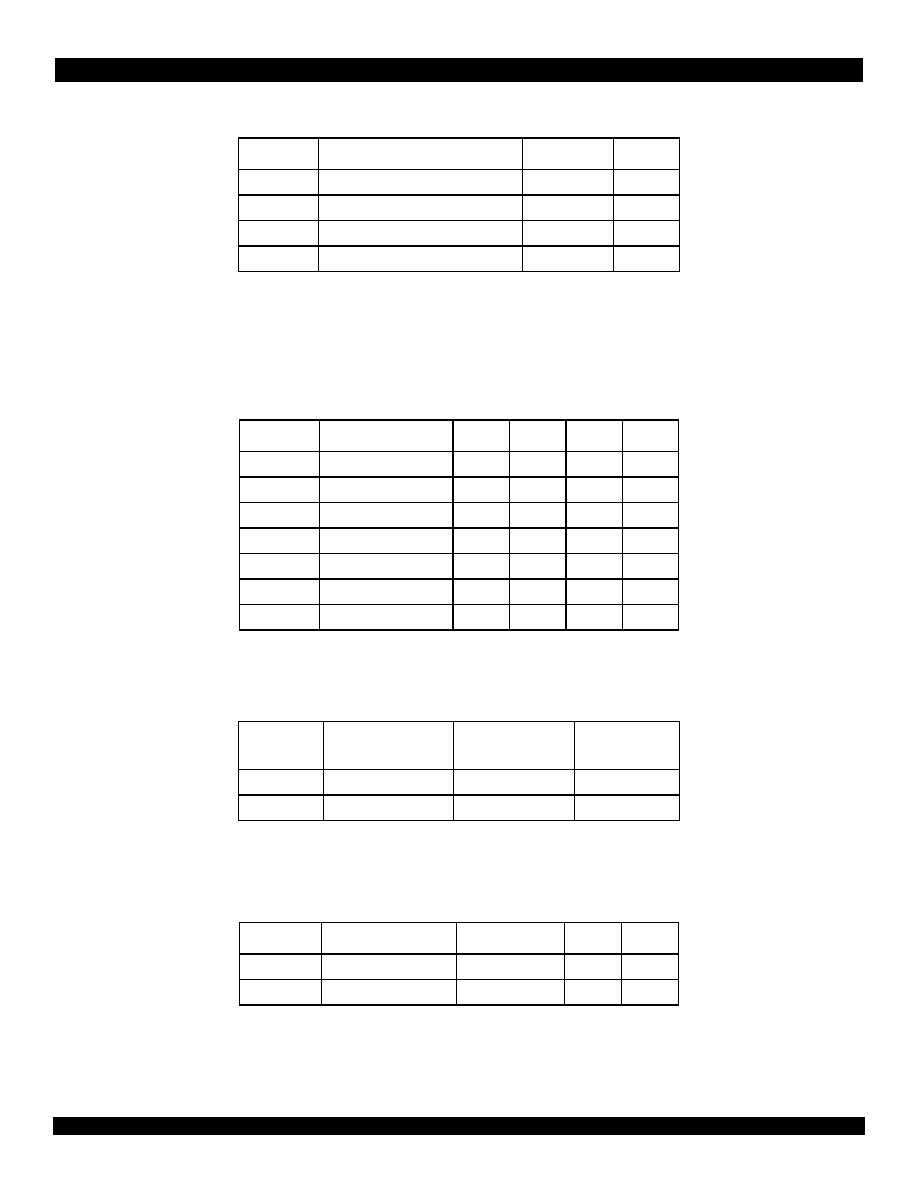
24 of 30
September 20, 2001
IDT77V126L200
Absolute Maximum Ratings
Absolute Maximum Ratings
Absolute Maximum Ratings
Absolute Maximum Ratings
Note: Stresses greater than those listed under ABSOLUTE MAXIMUM RATINGS may cause permanent damage to the device. This is a
stress rating only and functional operation of the device at these or any other conditions above those indicated in the operational sections of
this specification is not implied. Exposure to absolute maximum rating conditions for extended periods may affect reliability.
Recommended DC Operating Conditions
Recommended DC Operating Conditions
Recommended DC Operating Conditions
Recommended DC Operating Conditions
Recommended Operating Temperature and Supply Voltage
Recommended Operating Temperature and Supply Voltage
Recommended Operating Temperature and Supply Voltage
Recommended Operating Temperature and Supply Voltage
Capacitance (TA = +25
Capacitance (TA = +25
Capacitance (TA = +25
Capacitance (TA = +25
∞
C, F = 1MHz)
C, F = 1MHz)
C, F = 1MHz)
C, F = 1MHz)
Symbol
Rating
Value
Unit
V
TERM
Terminal Voltage with Respect to GND -0.5 to +5.5
V
T
BIAS
Temperature Under Bias
-55 to +125
∞
C
T
STG
Storage Temperature
-55 to +120
∞
C
I
OUT
DC Output Current
50
mA
Symbol
Parameter
Min
Typ
Max
Unit
VDD
Digital Supply Voltage
3.0
3.3
3.6
V
GND
Digital Ground Voltage
0
0
0
V
VIH
Input High Voltage
2.0
--
5.25
V
VIL
Input Low Voltage
-0.3
--
0.8
V
AVDO
Analog Supply Voltage
3.0
3.3
3.6
V
AGND
Analog Ground Voltage
0
0
0
V
VDIF
VDD - AVDD
-0.5
0
0.5
V
Grade
Ambient
Temperature
GND, AGND
VDD, ADD
Commercial
0
∞
C to +70
∞
C
0V
3.3V ± 0.3V
Industrial
-40
∞
C to +85
∞
C
0V
3.3V ± 0.3V
Symbol
Parameter
Conditions
Max
Unit
C
IN
Input Capacitance
V
IN =
0V
10
pF
C
IO
I/O Capacitance
V
OUT =
0V
10
pF
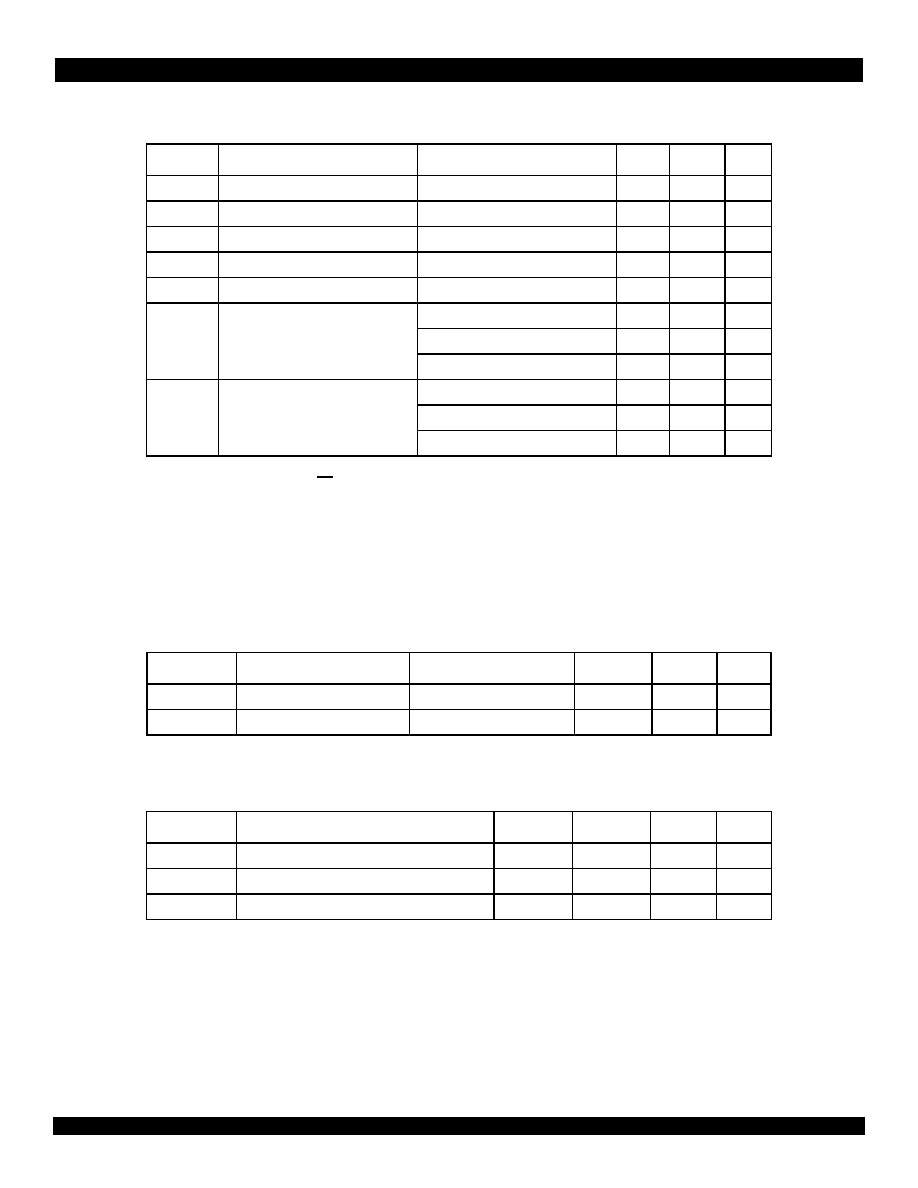
25 of 30
September 20, 2001
IDT77V126L200
DC Electrical Characteristics (All Pins except TX+/- and RX+/-)
DC Electrical Characteristics (All Pins except TX+/- and RX+/-)
DC Electrical Characteristics (All Pins except TX+/- and RX+/-)
DC Electrical Characteristics (All Pins except TX+/- and RX+/-)
DC Electrical Characteristics (TX+/- Output Pins Only)
DC Electrical Characteristics (TX+/- Output Pins Only)
DC Electrical Characteristics (TX+/- Output Pins Only)
DC Electrical Characteristics (TX+/- Output Pins Only)
DC Electrical Characteristics (RXD+/- Input Pins Only)
DC Electrical Characteristics (RXD+/- Input Pins Only)
DC Electrical Characteristics (RXD+/- Input Pins Only)
DC Electrical Characteristics (RXD+/- Input Pins Only)
Notes: 1. Differential signal amplitude is twice the amplitude of the individual signals which constitute the differential signal.
Symbol
Parameter
Test Conditions
Min.
Max. Unit
I
LI
Input Leakage Current
Gnd
VIN
VDD
-5
5
µA
I
LO
/O (as input) Leakage Current
Gnd
VIN
VDD
-10
10
µA
V
OH11
1.
For AD[7:0] pins only.
Output Logic "1" Voltage
I
OH
= -2mA, VDD = min.
2.4
--
V
V
OH22
2.
For all output pins except AD[7:0], INT and TX+/-.
Output Logic "1" Voltage
I
OH
= -8mA, VDD = min.
2.4
--
V
V
OL3
3.
For all output pins except TX+/-.
Output Logic "0" Voltage
I
OL
= -8mA, VDD = min.
--
0.4
V
I
DD14, 5
4.
Add 15mA for each TX+/- pair that is driving a load.
5.
Total supply current is the sum of IDD1 and IDD2
Digital Power Supply Current - VDD
OSC = 32 MHz, all outputs unloaded
--
90
mA
OSC = 64 MHz, all outputs unloaded
--
132
mA
OSC = 256 MHz, all outputs unloaded --
146
mA
I
DD25
Analog Power Supply Current - AVDD OSC = 32 MHz, all outputs unloaded
--
17
mA
OSC = 64 MHz, all outputs unloaded
--
19
mA
OSC = 256 MHz, all outputs unloaded --
34
mA
Symbol
Parameter
Test Conditions
Min.
Max.
Unit
V
OH1
Output Logic High Voltage
I
OH
= -20mA
VDD - 0.5V
--
V
V
OL
Output Logic Low Voltage
I
OL
= -20mA
--
0.5
V
Symbol
Parameter
Min.
Typ
Max.
Unit
V
IR
RXD+/- input voltage range
0
--
VDD
V
V
IP
RXD+/- input peak-to-peak differential voltage
0.6
--
2*VDD
V
V
ICM
RXD+/- input common mode voltage
1.0
VDD/2
VDD-0.5
V
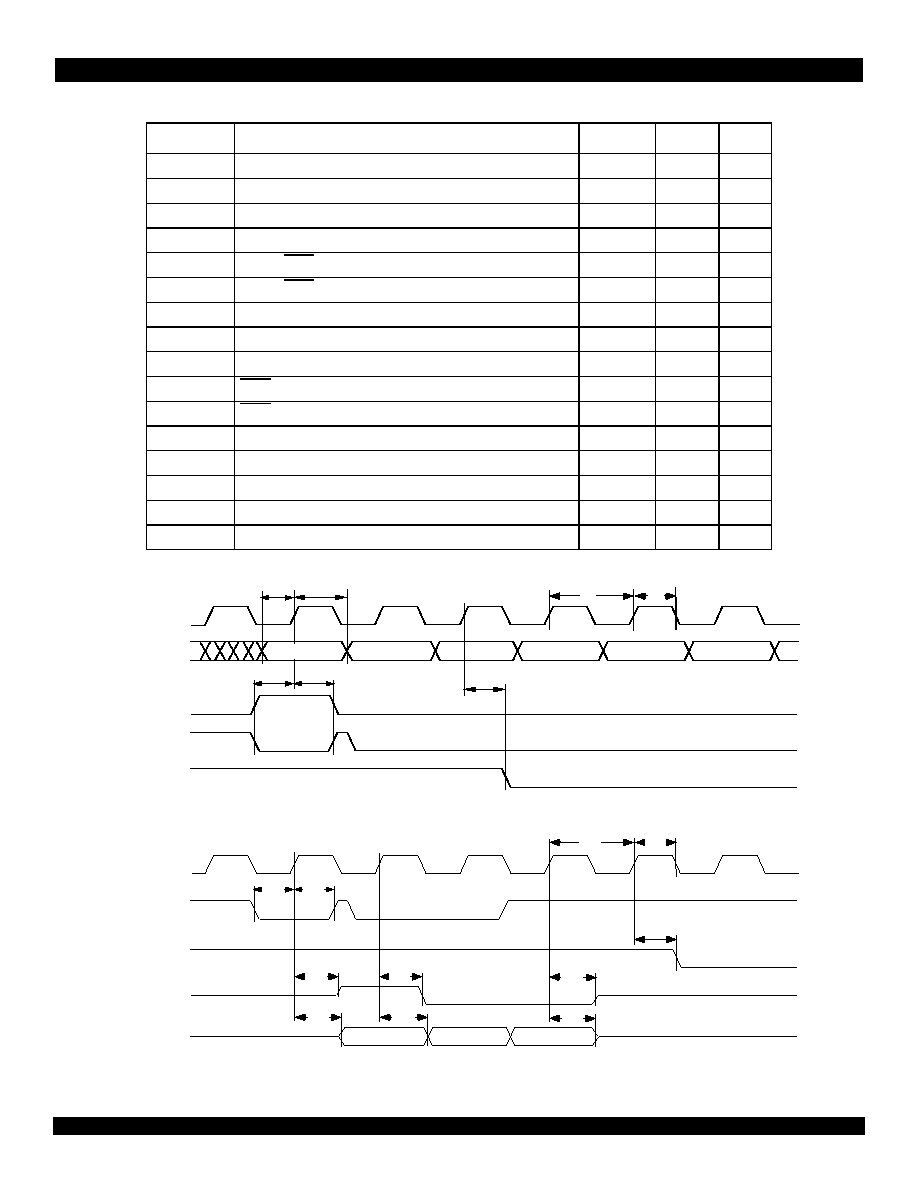
26 of 30
September 20, 2001
IDT77V126L200
UTOPIA Level 1 Bus Timing Parameters
UTOPIA Level 1 Bus Timing Parameters
UTOPIA Level 1 Bus Timing Parameters
UTOPIA Level 1 Bus Timing Parameters
Figure 17 UTOPIA 1 Transmit Timing Waveforms
Figure 18 UTOPIA 1 Receive Timing Waveforms
Symbol
Parameter
Min.
Max.
Unit
t31
TXCLK Frequency
0.2
50
MHz
t32
TXCLK Duty Cycle (% of t31)
40
60
%
t33
TXDATA[7:0], TXPARITY Setup Time to TXCLK
4
--
ns
t34
TXDATA[7:0], TXPARITY Hold Time to TXCLK
1.5
--
ns
t35
TXSOC, TXEN[3:0] Setup Time to TXCLK
4
--
ns
t36
TXSOC, TXEN[3:0] Hold Time to TXCLK
1.5
--
ns
t37
TXCLK to TXCLAV[3:0] Invalid (min) and Valid (max)
2
10
ns
t39
RXCLK Frequency
0.2
50
MHz
t40
RXCLK Duty Cycle (% of t39)
40
60
%
t41
RXEN[3:0] Setup Time to RXCLK
4
--
ns
t42
RXEN[3:0] Hold Time to RXCLK
1.5
--
ns
t43
RXCLK to RXCLAV[3:0] Invalid (min) and Valid (max)
2
10
ns
t44
RXCLK to RXSOC High-Z
2
10
ns
t45
RXCLK to RXSOC Low-Z (min) and Valid (max)
2
10
ns
t46
RXCLK to RXDATA, RXPARITY High-Z
2
10
ns
t47
RXCLK to RXDATA, RXPARITY Low-Z (min) and Valid (max)
2
10
ns
TXEN
TXCLAV
TXDATA[7:0],
TXPARITY
TXSOC
TXCLK
t
33
t
37
t
35
t
34
t
31
t
32
t
36
Octet 1
Octet 2
77v126 drw 39
77v106 drw 40
RXEN
RXCLAV
RXDATA[7:0],
RXPARITY
RXSOC
RXCLK
t
41
t
39
t
40
t
43
t
42
t
45
t
47
t
46
t
44
t
47
t
45
High-Z
High-Z
High-Z
High-Z
77v126 drw 40

27 of 30
September 20, 2001
IDT77V126L200
Utility Bus Read Cycle
Utility Bus Read Cycle
Utility Bus Read Cycle
Utility Bus Read Cycle
Utility Bus Write Cycle
Utility Bus Write Cycle
Utility Bus Write Cycle
Utility Bus Write Cycle
Figure 19 Utility Bus Read Cycle
Figure 20 Utility Bus Write Cycle
Name Min
Max Unit
Description
Name Min
Max Unit
Description
Tas
10
--
MHz
Address setup to ALE
Tapw
10
--
ns
ALE min pulse widt
Tcsrd
0
--
%
Chip select to read enable
Tas
10
--
ns
Address set up to ALE
Tah
5
--
ns
Address hold to ALE
Tah
5
--
ns
Address hold time to ALE
Tapw
10
--
ns
ALE min pulse width
Tcswr
0
--
ns
CS Assert to WR
Ttria
0
--
ns
Address tri-state to RD assert
Twrpw
20
--
ns
Min. WR pulse width
Trdpw
20 --
ns
Min.
RD pulse width
Tdws
20
--
ns
Write Data set up
Tdh
0
--
ns
Data Valid hold time
Tdwh
10
--
ns
Write Data hold time
Tch
0
--
ns
RD deassert to CS deassert
Tch
0
--
ns
WR deassert to CS deassert
Ttrid
--
10
ns
RD deassert to data tri-state
Taw
20
--
ns
ALE low to end of write
Trd
--
18
ns
Read Data access
Tar
5
--
ns
ALE low to start of read
Trdd
0
--
ns
Start of read to Data low-Z
3505 drw 43
CS
RD
ALE
Tah
Tas
Tapw
Tch
Trdd
Trdpw
AD[7:0]
(output)
Tdh
Trd
Ttrid
Tcsrd
Address
Data
Tar
AD[7:0]
(input)
3505 drw 44
CS
WR
ALE
AD[7:0]
Tah
Tas
Tapw
Tch
Tdwh
Tdws
Twrpw
Address
Data (input)
Taw
Tcswr
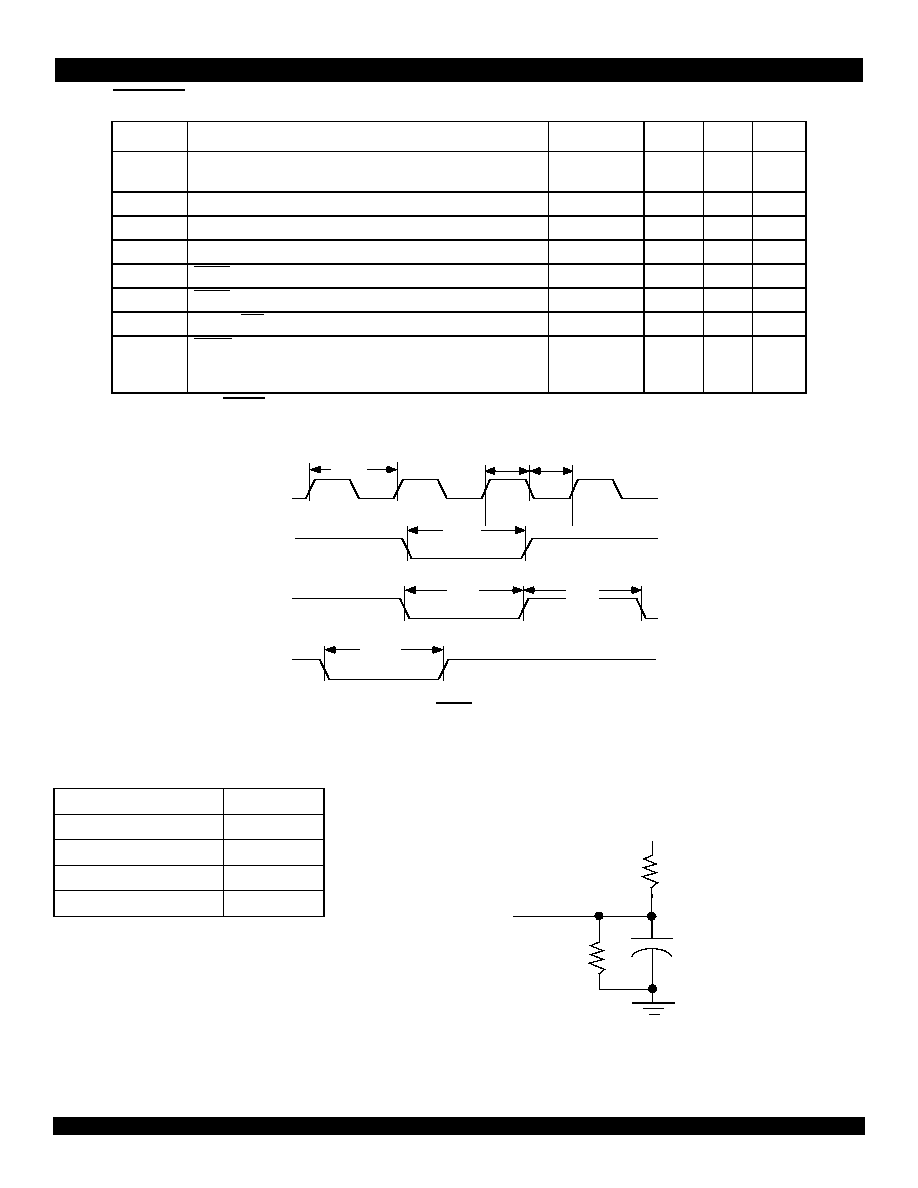
28 of 30
September 20, 2001
IDT77V126L200
OSC,
OSC,
OSC,
OSC, TXREF
TXREF
TXREF
TXREF and Reset Timing
and Reset Timing
and Reset Timing
and Reset Timing
Note: The minimum RESET Pulse Width is either two RxCLK cycles, two TxCLK cycles, or two OSC cycles, whichever is greater (and
applicable).
Figure 21 OSC, TXREF and Reset Timing
AC Test Conditions
AC Test Conditions
AC Test Conditions
AC Test Conditions
Symbol
Parameter
Min
Typ
Max
Unit
Tcyc
OSC cycle period (25.6 Mbps)
(51.2 Mbps)
30
15
31.25
15.625
33
16.5
ns
ns
Tckh
OSC high time
40
--
60
%
Tckl
OSC low time
40
--
60
%
Tcc
OSC cycle to cycle period variation
--
--
1
%
Ttrh
TXREF High Time
35
--
--
ns
Ttrl
TXREF Low Time
35
--
--
ns
Trspw
Minimum RST Pulse Width
two OSC cycles
--
--
--
Trrpw
RXREF Pulse Width (For default setting in register 0x03 and 25.6
Mbps. Can be programmed for multiples of this amount.)
0.9
1
(31.25ns)
1.1
Receive
Data Bit
Period
Input Pulse Levels
GND to 3.0V
Input Rise/Fall Times
3ns
Input Timing Reference Levels
1.5V
Output Reference Levels
1.5V
Output Load
See Figure 22
Figure 22 Output Load
3505 drw 45
OSC
RST
Trspw
TXREF
Ttrl
Ttrh
Tcyc
Tckh
Tckl
.
RXREF
Trrpw
900
1.2K
3.3V
30pF*
* Includes jig and scope capacitances.
D.U.T.
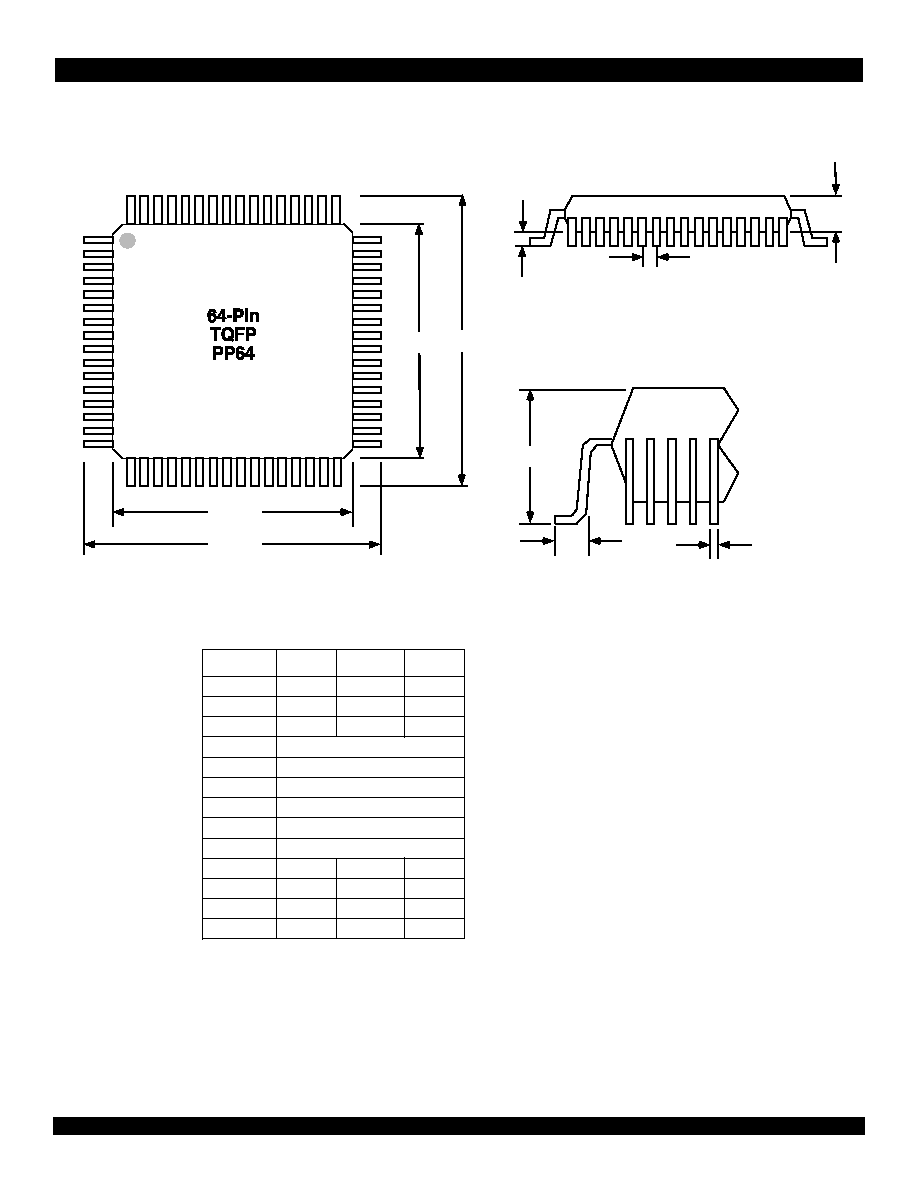
29 of 30
September 20, 2001
IDT77V126L200
Package Dimensions
Package Dimensions
Package Dimensions
Package Dimensions
PSC-4046 is a more comprehensive package outline drawing which is available from the packaging section of the IDT web site.
2.4792 '
1
64
A1
A2
e
b
L
5.5125 '
D
4.4458 '
D1
A
4.3514 '
5.4035 '
E1
77v106 drw 49
E
77v106 drw 03
A
A1
A2
D
D1
E
E1
N
e
b
b1
ccc
ddd
-
.05
1.35
.17
.17
-
-
-
.10
1.40
12.00 BSC
10.00 BSC
12.00 BSC
10.00 BSC
64
.50 BSC
.22
.20
-
-
1.60
.15
1.45
.27
.23
.08
.08
SYMBOL
MIN.
NOM.
MAX.
Dimensions are in millimeters
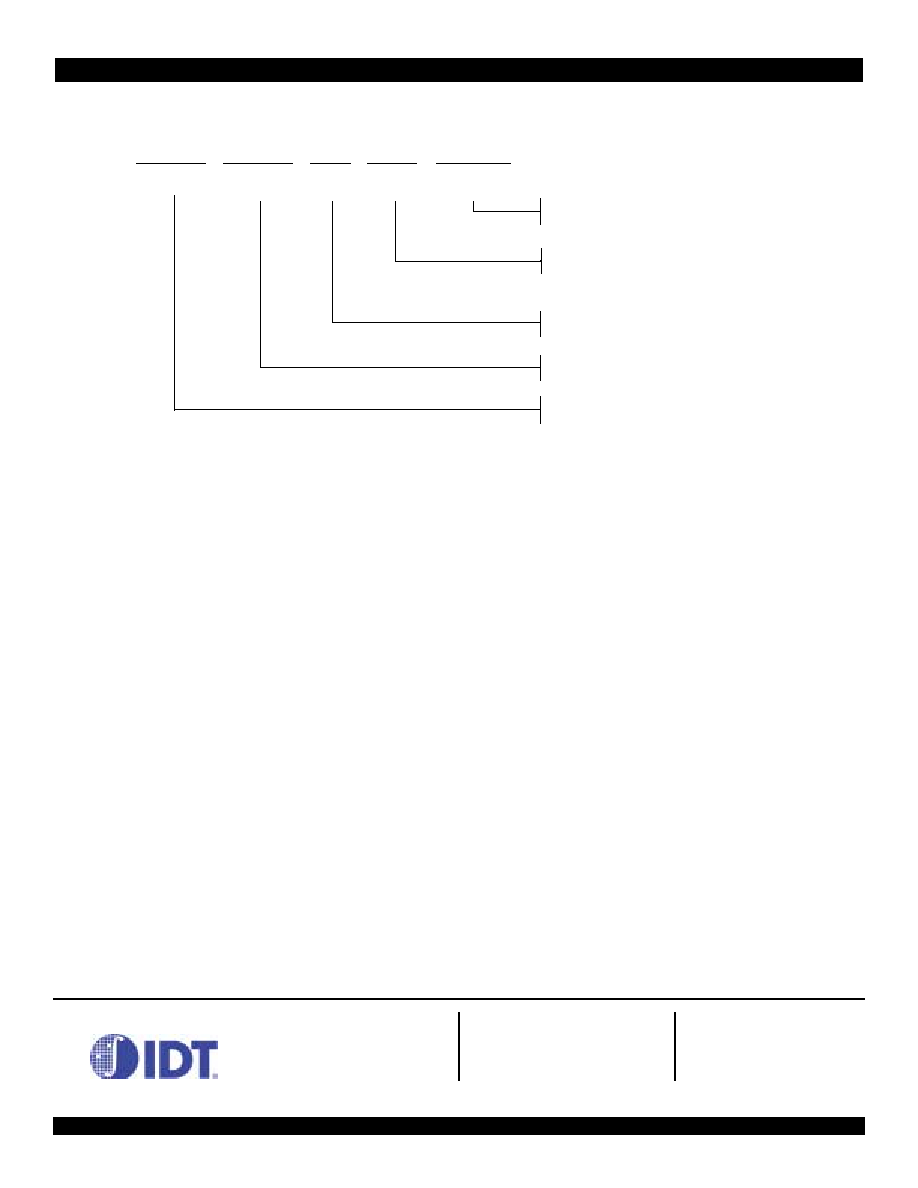
30 of 30
September 20, 2001
IDT77V126L200
CORPORATE HEADQUARTERS
2975 Stender Way
Santa Clara, CA 95054
for SALES:
800-345-7015 or 408-727-6116
fax: 408-330-1748
www.idt.com
for Tech Support:
email: phyhelp@idt.com
phone: 408-330-1752
Ordering Information
Ordering Information
Ordering Information
Ordering Information
Revision History
Revision History
Revision History
Revision History
September 20, 2001: Initial publication.
Package
IDT
NNNNN
Device Type
A
Power
NNN
Speed
A
A
Process/
Temp. Range
Blank
200
Speed in Mb/s
77V106
200Mbps ATM PHY 3.3V
Commercial (0∞C to +70∞C)
77v106 drw 50
L
TF
64-Lead TQFP (PP64-1)
I
Industrial (-40∞C to +85∞C)
.
77V126





























